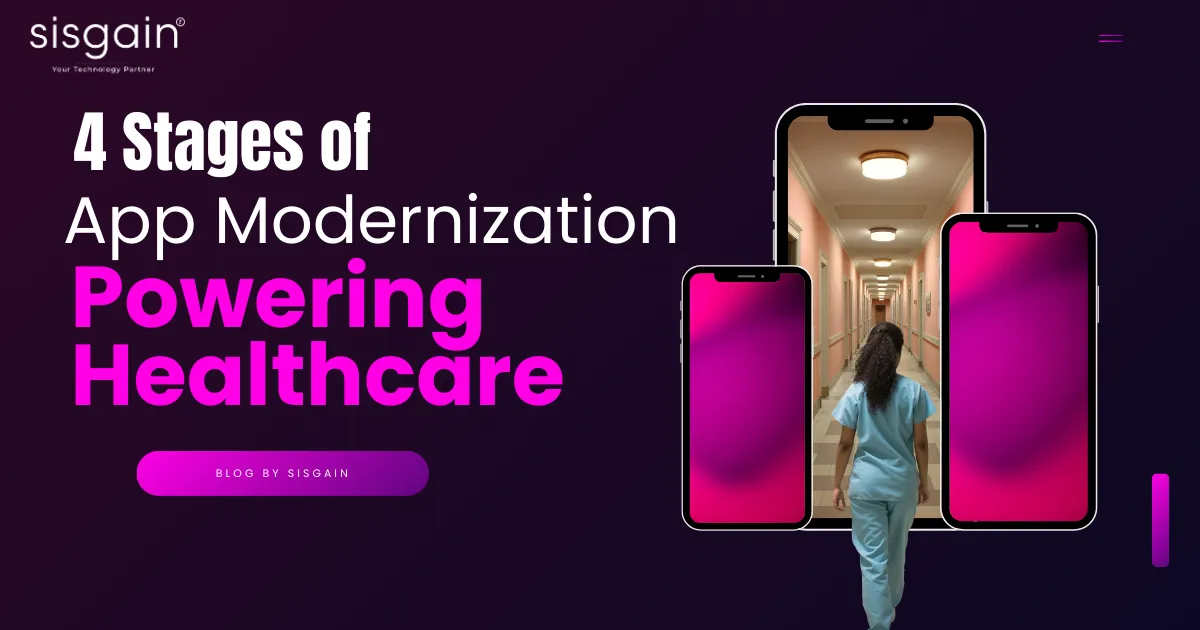Sales Team
Project quotes, partnerships, implementation

Healthcare has always been a sector where reliability and efficiency matter the most. But today, technology has become just as important as medical expertise. Hospitals and clinics generate vast amounts of patient data daily. Patients expect fast digital services, real-time communication, and easy access to their health records. At the same time, providers need to stay compliant with strict regulations like HIPAA while keeping costs under control.
Legacy systems, which were once the backbone of healthcare IT, now struggle to meet these demands. They are expensive to maintain, slow to scale, and difficult to integrate with modern technologies such as cloud computing, AI, and wearable devices. To keep pace with innovation, healthcare organizations are turning toward application modernization in healthcare.
This process allows providers to transform old, rigid systems into modern healthcare software solutions that are scalable, secure, and patient-friendly. Whether it’s cloud migration for healthcare apps, developing intelligent medical software solutions, or deploying patient monitoring software, modernization is the bridge between outdated systems and the future of healthcare.
In this blog, we’ll explore the four stages of app modernization in healthcare—assessment, migration, modernization, and optimization. We’ll also highlight challenges, opportunities, and real-world examples to show how modernization powers healthcare digital transformation.
Before exploring the stages, let’s understand why modernization is now essential in healthcare.
Key reasons include:
App modernization in healthcare is a step-by-step process that helps providers upgrade legacy systems, improve security, and adopt intelligent solutions. The four stages—assessment, migration, modernization, and optimization—combined with expert medical software development services, create scalable healthcare applications that drive digital transformation, enhance patient care, and ensure full compliance with HIPAA standards.

Every modernization journey begins with a detailed assessment of existing applications. Healthcare providers need to ask critical questions about scalability, compliance, security, and integration, identifying weaknesses in legacy systems to build a clear roadmap for digital transformation and future-ready healthcare solutions.
Challenges with legacy systems:
Assessment activities often include:
Example: A hospital in the US realized during its assessment that its appointment scheduling system could not sync with online teleconsultation tools. Patients faced delays, and staff wasted hours on manual updates. This assessment stage laid the foundation for their modernization strategy.

Once the assessment reveals gaps in legacy systems, the next crucial step is migration. In healthcare, this often involves moving applications and sensitive patient data to secure cloud platforms. Cloud migration for healthcare apps enables scalability, better accessibility, and stronger collaboration. It reduces infrastructure costs, improves efficiency, and ensures compliance, while also creating a flexible environment where providers can integrate modern technologies, enhance patient care, and prepare for future digital transformation.
Benefits of migration include:
Common migration strategies in healthcare:
Case study: A healthcare network migrated its patient monitoring software to the cloud, allowing doctors to track real-time data from home-care patients. This reduced emergency hospital visits and improved patient outcomes.

Migration sets the stage, but true transformation happens during modernization. At this stage, healthcare applications are upgraded with advanced capabilities like AI, IoT integration, and intelligent features. Modernization improves efficiency, strengthens compliance, enhances patient engagement, and builds smarter systems designed to meet evolving healthcare demands.
Trends in modernization include:
Advantages of modernization:
Example: A clinic modernized its legacy billing system by adding AI-driven automation. This reduced claim processing time by 40% and significantly cut administrative overhead.

The final stage is optimization, which ensures that modernized apps continue to evolve. In healthcare, optimization is critical because patient needs, regulations, and technologies are constantly changing.
Optimization practices include:
Example: A telehealth provider optimized its consultation platform by adding AI-based call routing. This reduced wait times for patients and improved satisfaction scores by over 30%.
Through optimization, healthcare organizations can ensure their apps remain effective, compliant, and ready for the next wave of digital innovation.
While modernization brings immense benefits, it also comes with challenges that healthcare organizations and medical software companies must address:
Despite challenges, modernization creates major opportunities for medical software development and related services.
Forward-thinking providers are seeking trusted partners for medical software development services who can help them embrace modernization and lead their healthcare digital transformation journeys.
Healthcare digital transformation is about reimagining care delivery using advanced technologies. Modernization plays a vital role in this transformation by:
In essence, modernization is not just about updating software—it’s about building the foundation for smarter, patient-focused care.
Healthcare cannot continue to rely on outdated applications in a digital-first world. Patients expect secure, fast, and intelligent solutions, while providers must meet regulatory demands and stay competitive. The 4 stages of app modernization—assessment, migration, modernization, and optimization—offer a clear roadmap to achieve this transformation.
By embracing legacy application modernization in healthcare, organizations can improve scalability, security, and patient outcomes. From cloud migration for healthcare apps to intelligent medical software solutions, modernization ensures that healthcare is ready for the future.
At SISGAIN, we specialize in building modern healthcare software solutions that align with regulatory needs and future innovation. As a trusted healthcare software development company , we help providers adopt the right strategies for app modernization, ensuring better care delivery and stronger outcomes.
Ready to transform your healthcare systems? Partner with SISGAIN for future-ready solutions that power digital healthcare.
Project quotes, partnerships, implementation
Open roles, referrals, campus hiring